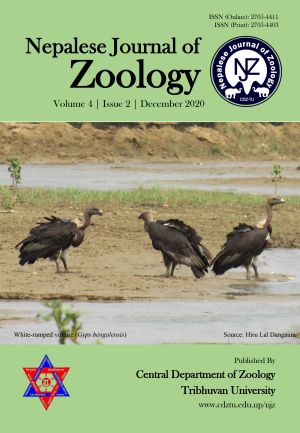Avian richness of the Basanta Protected Forest, far-western lowland Nepal: Implication for conservation
DOI:
https://doi.org/10.3126/njz.v4i2.33886Keywords:
Bird Community, Ghodaghodi, Forest, Vantage points, PassertiformesAbstract
Birds are important components of biodiversity and acts as an indicator of habitat quality, productivity and stability. This study aimed to document species richness and assess the temporal distribution pattern of globally threatened bird species in the Basanta Protected Forest (BPF), one of the largest corridor forests which connects Dudhwa National Park (India) with protected areas of western lowland Nepal. During study period of ten years from 2010 to 2019, a total of 381 bird species from 78 families of 19 orders were recorded. Order Passeriformes had the highest species richness (n=180) followed by order Accipitriformes and Charadriiformes. Among the families, the family Muscicapidae had the highest species richness (n=31), followed by Accipitridae and Anatidae. Majority of bird recorded were forest bird followed by wetland and farmland bird species. Fifteen globally threatened species like red-headed vulture (Sarcogyps calvus), white-rumped vulture (Gyps bengalensis), slender-billed vulture (Gyps tenuirostris), steppe eagle (Aquila nipalensis) and Egyptian vulture (Neophron percnopterus) were recorded in the BPF. Extensive avian survey in the BPF is important for further exploration of avian community along with its driving factors, which might play a crucial role in developing baseline information and implementing conservation implications.
Downloads
Downloads
Published
How to Cite
Issue
Section
License
This license enables reusers to distribute, remix, adapt, and build upon the material in any medium or format for noncommercial purposes only, and only so long as attribution is given to the creator.

